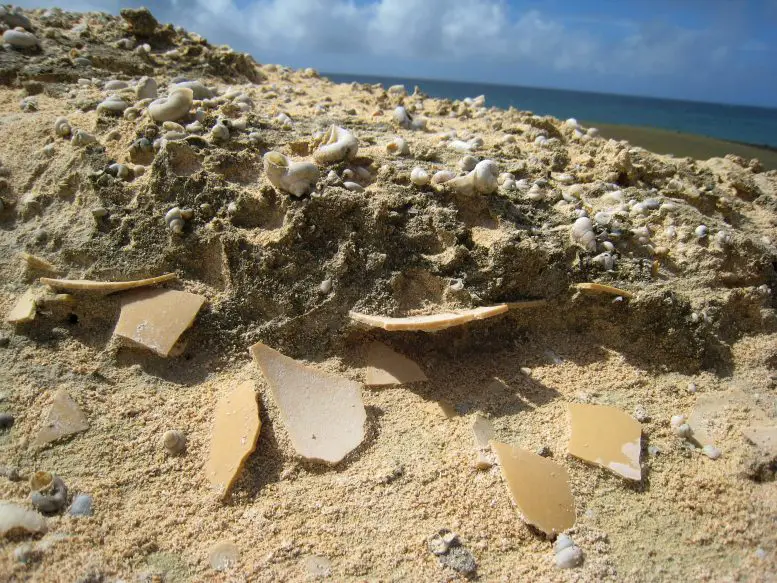A long time ago, giant flightless birds called elephant birds lived on Madagascar. They laid eggs which were even bigger than footballs! Unfortunately, these large birds are no longer around today. But researchers from the University of Colorado Boulder and Curtin University in Australia have discovered that the eggshells left behind by elephant birds can give us information about when they used to live there.
Recently, scientists published a study in the journal Nature Communications that revealed the discovery of an unseen type of elephant bird living in Madagascar. It was found without the need to find bones – pretty amazing!
This is the first time ever that a new kind of elephant bird has been discovered just by looking at ancient eggshells! It’s an amazing achievement that lets scientists discover more about all the birds that used to live on Earth and why so many have become extinct in the last 10,000 years.
“This is the first time we’ve used eggshells from an elephant bird to identify something,” said Gifford Miller, a professor of geological sciences. He works at the Institute of Arctic and Alpine Research (INSTAAR) at CU Boulder. Miller continued his statement with, “This allows us to think back in time: Were there more types of birds than we already know about?”
Madagascar has been isolated from other countries around it by the deep ocean for more than 60 million years. This has caused animals to evolve differently on this big island, making creatures like lemurs and elephant birds that don’t exist anywhere else in the world. Around 2,000 years ago, some Polynesian people arrived and saw these huge birds called Aepyornis – they were over 9 feet tall and weighed well over 1,500 pounds! They had strong beaks and their feet had sharp talons so they were pretty intimidating. Aepyornis was the largest land animal in Madagascar.

Scientists had a difficult time knowing where the elephant birds belonged in the evolutionary tree since there were not many skeletal remains and bone DNA breaks down quickly in very hot and humid areas. What was known, though, is that they come from the same family of flightless creatures as the kiwi, who live in New Zealand and are the smallest of all ratite animals.
However, new evidence gathered from ancient eggshells has made it clear where these birds belong on the genetic family tree, as well as how unique each one can be!
Alicia Grealy, who did research for her doctoral thesis at Curtin University in Australia, stated that she found different species of birds in the far north of Madagascar. These findings are important because they help us to learn more about these mysterious birds. Amazingly enough we learned this by looking at their eggshells!
Table of Contents
Unearthing the Lost World of the Elephant Bird
Miller has spent more than 20 years researching eggshells from Australia and other places in the world. When he won $25,000 from the Geological Society of America’s Easterbrook Distinguished Scientist Award in 2005, Miller formed a small team to learn about the elephant bird, which is very hard to study.
The team began their project in 2006 to collect eggshells from the dry part of the island. But before they could finish, somebody else used parts of bones to figure out what kind of bird it was. So, Miller and Grealy’s group changed their plan and focused their efforts on the wet, forested north half of the island to learn more about this bird in another environment.

Scientists used high-tech satellite pictures to find spots on the island where sand had been blown away and left behind old eggshells. Since there are no large birds on the island, it made it easier to spot these eggshell pieces with just their eyes. After exploring the whole island and collecting 960 eggshell pieces from 291 locations, they then went to work analyzing the old DNA found inside these shells.
Skeletons often give away their DNA too easily, so they aren’t a good choice to study. Eggshells, on the other hand, are special since their chemistry locks the organic matter inside and protects it for up to 10,000 years. This means it’s harder to take out the sample we need for analysis.
Scientists had a problem—they needed longer strands of DNA to study, but the ones they were dealing with were often too weak or broken up. To fix this, they piece together the small pieces of genetic material like a “puzzle”, and amazingly enough, they found something new: an elephant bird!
Miller, the director at GAGE (Center for Geochemical Analysis of the Global Environment) from CU Boulder, said that science progresses in unique ways. You don’t always get what you were looking for, but it’s a lot more exciting to find out about something you didn’t even know you were searching for.
Uncovering the Mysteries of Earth’s Recent History with the Help of DNA and Technology
Miller studies Earth’s recent history, called the “Quaternary”, which was when humans first started showing up. Even though we don’t know why it happened, this period also saw many big animals such as the elephant bird going extinct. For a long time, people have been arguing about what actions early humans might have taken to cause these extinctions. Miller has been studying this problem and asking questions about it for fifty years!
Studying the DNA from eggshells can help scientists figure out why massive animals like elephant birds disappeared after humans appeared. If experts such as geologists, archaeologists, and biologists find more samples of eggshell to look at and date, then the research on this subject could become much more understandable.
Miller stated that with help from many people, you can answer some difficult questions. This may give us a different perspective on them.
A team of scientists recently conducted a study called “Molecular exploration of fossil eggshell” to learn more about an extinct, giant bird. This work was published in the journal Nature Communications on February 28th, 2023. The team looked at different molecules found on the fossilized remains of the bird’s eggshells to uncover evidence that this giant bird was closely related to modern day birds. Their findings showed us more about these fascinating creatures and will help guide further research into preserving our natural environment.
Reference: “Molecular exploration of fossil eggshell uncovers hidden lineage of giant extinct bird” by Alicia Grealy, Gifford H. Miller, Matthew J. Phillips, Simon J. Clarke, Marilyn Fogel, Diana Patalwala, Paul Rigby, Alysia Hubbard, Beatrice Demarchi, Matthew Collins, Meaghan Mackie, Jorune Sakalauskaite, Josefin Stiller, Julia A. Clarke, Lucas J. Legendre, Kristina Douglass, James Hansford, James Haile and Michael Bunce, 28 February 2023, Nature Communications.
DOI: 10.1038/s41467-023-36405-3
This paper was written by a lot of people from different universities. They are Matthew J. Phillips from Queensland University of Technology, Simon J. Clarke from Integrity Ag & Environment, Marilyn Fogel from University of California Riverside, Diana Patalwala and Paul Rigby and Alysia Hubbard from The University of Western Australia, Beatrice Demarchi from University of Turin, Matthew Collins, Meaghan Mackie, Jorune Sakalauskaite and Josefin Stiller from University of Copenhagen, Julia A. Clarke and Lucas J. Legendre from The University of Texas at Austin ,Kristina Douglass from Columbia University, James Hansford from Zoological Society of London , Northern Illinois University and the University College London ,James Haile Oxford Univeristy lastly Michael Bunce Curtin Universtiy.
The money to do this research was kindly donated by different organizations such as the Geological Society of America, the National Science Foundation, and the Australian Research Council. It all helped with a survey of how many pre-school children had intestinal schistosomiasis (a disease) in Madagascar’s Marolambo District. https://www.nature.com/articles/s41467-023-36405-3
Frequently Asked Questions About Elephant Birds
Why did elephant birds go extinct?
Elephant birds went extinct due to a combination of human hunting, habitat destruction, and climate changes. The birds were heavily hunted for food and their eggs, which were much larger than those of any other bird. As their numbers dwindled, their habitats were destroyed by human activity, leaving them without suitable places to breed and feed. Additionally, climate changes in the region in which they lived likely contributed to their decline.
Are elephant birds extinct?
Yes, elephant birds are extinct. They are an extinct family of large flightless birds that were native to Madagascar. They became extinct sometime between the 17th and 19th centuries, likely due to human hunting and habitat destruction.
How big is an elephant bird?
Elephant birds were an extinct family of giant flightless birds that lived on the island of Madagascar until they became extinct around 1000 years ago. They are believed to have been the largest birds ever to exist, and they were estimated to be around 8 feet tall and weigh up to 880 pounds.
Is an elephant bird an ostrich?
No, an elephant bird is not an ostrich. Elephant birds were giant, flightless birds that lived on the island of Madagascar until they became extinct around the 17th century. Ostrich, on the other hand, are large, flightless birds that live in Africa, the Middle East, and parts of Asia.
Is the elephant bird extinct?
Yes, the elephant bird is extinct. It is believed to have gone extinct sometime between 1000 and 1500 AD.
When was the elephant bird alive?
The elephant bird (Aepyornis maximus) was a giant, flightless bird that lived on the island of Madagascar until it became extinct sometime between the 12th and 17th centuries.


